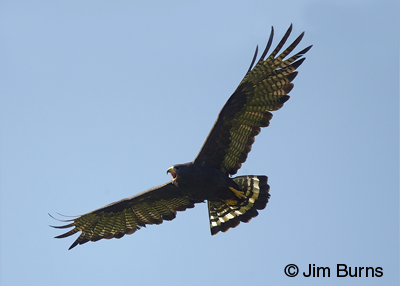
Zone-tailed hawk, like common black-hawk, is a buteo, the family of daytime raptors characterized by broad wings and short tails typically seen soaring overhead in midday thermals. Zone-taileds, however, have adopted an unusual hunting method known as behavioral mimicry, and are frequently seen, not individually, but soaring with groups of turkey vultures.
Zonies are beautiful, dark raptors with multiple white tail bands, one wide and one narrow on males, two narrow on females. From above, these bands will appear gray. When seen overhead, zonies soar with the dihedral (upswept wings) of the turkey vultures with which they often associate.
Here's how behavioral mimicry works as practiced by zone-tailed hawks. With silvery flight feathers giving the same underwing appearance as the vultures and wings set in a dihedral, zone-taileds rock from side to side in flight like the vultures. Prey species (and birders too), habituated to the more abundant, harmless, carrion seeking vultures, dismiss the hawks as just another vulture. When a zonie in a kettle of vultures spots prey, it will continue to circle but slip slowly lower and to the outside edge of its hosts, pass from sight behind intervening cover such as a rock or bush, then strike unexpectedly from behind the temporary concealment.
Seen soaring with the vultures or hunting individually, zone-taileds glide along slowly, appearing casual or even lazy, but they are capable of breathtakingly rapid, falcon-like stoops when prey is sighted. They subsist primarily on small mammals and lizards, but will also take large insects and small birds up to the size of quail, sometimes snatching them with their talons in full flight. Broken terrain may be the preferred habitat because the cover it provides is so well-suited to the hunting style these buteos have perfected.
Zonies typically nest in tall, isolated trees along canyon streams, but sometimes use hillside evergreens or cliff ledges and grottoes. Like black-hawks, zone-taileds build large stick platform nests often used several years in succession, a few sprigs of fresh greenery newly added each spring as a pesticide. It is almost impossible to discover a nest before the parents discover you, protesting your approach with long, thin, piercing screams. Always observe nests from a distance so as not to disturb the hawks. Or have them disturb you--zone-taileds have been known to attack human intruders who get too close during nesting season.
Zone-tailed Hawks are not common, and they're easy to miss. Don't dismiss that big dark bird in the distance as just another turkey vulture. Get the binoculars on it and glass carefully. The tail bands are the giveaway. Watch for zone-taileds along Camp Creek and around Mt. Ord north of Phoenix and above Pinal Peak east of Phoenix. The very best place is along Sycamore Creek north of Sunflower, and the very best time is right now as spring migrants pass through.